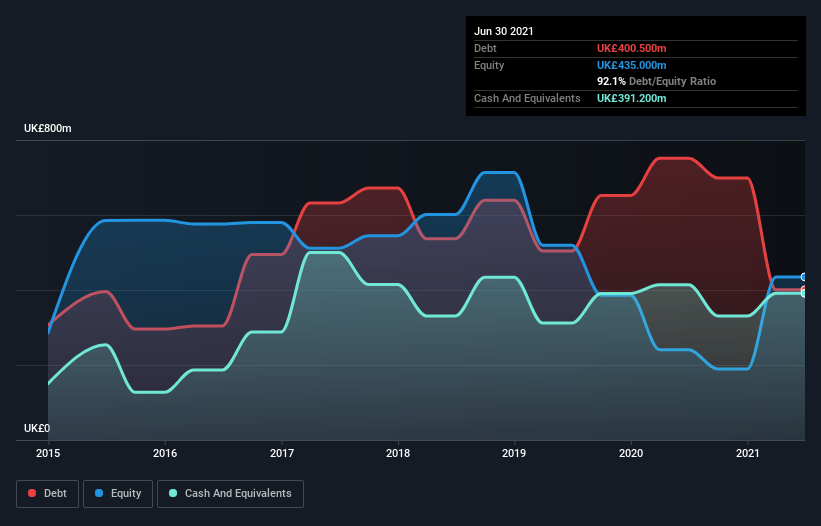David Iben put it well when he said, 'Volatility is not a risk we care about. What we care about is avoiding the permanent loss of capital.' When we think about how risky a company is, we always like to look at its use of debt, since debt overload can lead to ruin. We note that Kier Group plc (LON:KIE) does have debt on its balance sheet. But the real question is whether this debt is making the company risky.
What Risk Does Debt Bring?
Generally speaking, debt only becomes a real problem when a company can't easily pay it off, either by raising capital or with its own cash flow. In the worst case scenario, a company can go bankrupt if it cannot pay its creditors. However, a more usual (but still expensive) situation is where a company must dilute shareholders at a cheap share price simply to get debt under control. Having said that, the most common situation is where a company manages its debt reasonably well - and to its own advantage. The first step when considering a company's debt levels is to consider its cash and debt together.
Check out our latest analysis for Kier Group
How Much Debt Does Kier Group Carry?
The image below, which you can click on for greater detail, shows that Kier Group had debt of UK£400.5m at the end of June 2021, a reduction from UK£751.4m over a year. However, because it has a cash reserve of UK£391.2m, its net debt is less, at about UK£9.30m.

How Healthy Is Kier Group's Balance Sheet?
Zooming in on the latest balance sheet data, we can see that Kier Group had liabilities of UK£1.23b due within 12 months and liabilities of UK£612.5m due beyond that. Offsetting these obligations, it had cash of UK£391.2m as well as receivables valued at UK£509.5m due within 12 months. So its liabilities outweigh the sum of its cash and (near-term) receivables by UK£945.3m.
This deficit casts a shadow over the UK£467.0m company, like a colossus towering over mere mortals. So we'd watch its balance sheet closely, without a doubt. After all, Kier Group would likely require a major re-capitalisation if it had to pay its creditors today.
In order to size up a company's debt relative to its earnings, we calculate its net debt divided by its earnings before interest, tax, depreciation, and amortization (EBITDA) and its earnings before interest and tax (EBIT) divided by its interest expense (its interest cover). This way, we consider both the absolute quantum of the debt, as well as the interest rates paid on it.
Kier Group has a very low debt to EBITDA ratio of 0.13 so it is strange to see weak interest coverage, with last year's EBIT being only 1.2 times the interest expense. So one way or the other, it's clear the debt levels are not trivial. We also note that Kier Group improved its EBIT from a last year's loss to a positive UK£45m. When analysing debt levels, the balance sheet is the obvious place to start. But ultimately the future profitability of the business will decide if Kier Group can strengthen its balance sheet over time. So if you want to see what the professionals think, you might find this free report on analyst profit forecasts to be interesting.
Finally, while the tax-man may adore accounting profits, lenders only accept cold hard cash. So it is important to check how much of its earnings before interest and tax (EBIT) converts to actual free cash flow. During the last year, Kier Group generated free cash flow amounting to a very robust 84% of its EBIT, more than we'd expect. That positions it well to pay down debt if desirable to do so.
Our View
To be frank both Kier Group's interest cover and its track record of staying on top of its total liabilities make us rather uncomfortable with its debt levels. But on the bright side, its conversion of EBIT to free cash flow is a good sign, and makes us more optimistic. Looking at the balance sheet and taking into account all these factors, we do believe that debt is making Kier Group stock a bit risky. That's not necessarily a bad thing, but we'd generally feel more comfortable with less leverage. There's no doubt that we learn most about debt from the balance sheet. But ultimately, every company can contain risks that exist outside of the balance sheet. We've identified 1 warning sign with Kier Group , and understanding them should be part of your investment process.
When all is said and done, sometimes its easier to focus on companies that don't even need debt. Readers can access a list of growth stocks with zero net debt 100% free, right now.
Valuation is complex, but we're here to simplify it.
Discover if Kier Group might be undervalued or overvalued with our detailed analysis, featuring fair value estimates, potential risks, dividends, insider trades, and its financial condition.
Access Free AnalysisHave feedback on this article? Concerned about the content? Get in touch with us directly. Alternatively, email editorial-team (at) simplywallst.com.
This article by Simply Wall St is general in nature. We provide commentary based on historical data and analyst forecasts only using an unbiased methodology and our articles are not intended to be financial advice. It does not constitute a recommendation to buy or sell any stock, and does not take account of your objectives, or your financial situation. We aim to bring you long-term focused analysis driven by fundamental data. Note that our analysis may not factor in the latest price-sensitive company announcements or qualitative material. Simply Wall St has no position in any stocks mentioned.
About LSE:KIE
Kier Group
Primarily engages in the construction business in the United Kingdom and internationally.
Acceptable track record with mediocre balance sheet.
Similar Companies
Market Insights
Community Narratives



